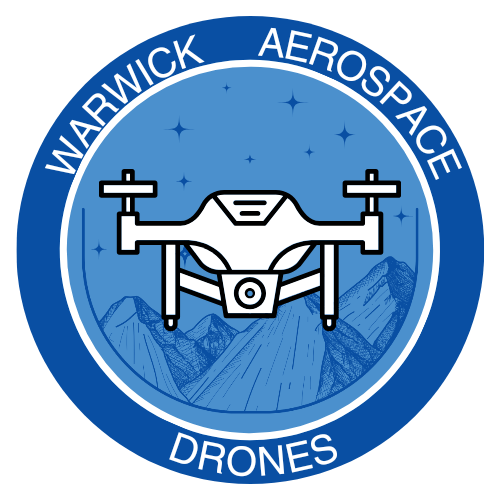
Outline:
The society has previously constructed and flown our own drone. Having identified some areas to work on we’re currently making some improvements and hope to have it flying again soon! Our long term goal is to mount a spotlight to the base in order to provide lighting. One use of this would be in search and rescue where currently a helicopter is called when lighting is required.
A drone is an unmanned, which consists of any vehicle without a human on board. It may be controlled by a human operator Or controlled by onboard computers. There are different types including: Unmanned Aerial Vehicle (UAV), Unmanned/Autonomous Ground Vehicle (UGV/AVG), and Unmanned/Autonomous Underwater Vehicle (UUV/AUV)
The society has previously constructed and flown its own drone, but this year aims to design. construct and build a hexacopter drone and a separate swarm drone, with the goal of developing technology for environmental surveillance
Objectives:
- To manufacture a hexacopter system with autonomous capabilities.
- To manufacture a swarm drone in collaboration with Robotics Society
Goals:
- Flight time: to operate in the air for more than 30 minutes
- Payload capacity: to be able to carry more than 2kg, including extra capability equipment
- autonomus operation: to perform tasks with minimal manual intervention (eg obstacle avoidance and navigation)
- Weather Resistance: to make it weatherproof and include increased flight stability
- Integration of other technology: for example HD cameras
Introducing the Team
(add images of the leads)
Project Manager: Kieron Drilon (2nd year Electronic Engineering)
Deputy Project Manager: Shreeya Srivastava (1st Year Biomedical Systems Engineering)
Sub-Teams:
Project Management:
- responsible for the overall project planning, co-ordination and execution of the drone
- manages timelines, budgets and resources
hardware Mechanical
- use fusion 360 to design drone frames based on the components and dimensions provided by research and procurement teams
Hardware Electrical
- design suitable systems architecture and circuit schematic
- ensure smooth control and operation whilst drone is in flight
(add some pictures)
Drone Components
FRAME
The frame is the basic structure that holds all the components together. It provides stability and protection to the internal components
BLDC Motors
Drones typically have four or more motors, each connected to a propeller. The motors generate the necessary thrust to lift and manoeuvre the drone.
Motors work by converting electrical energy into mechanical energy. This mechanical energy is then used to spin the propellers, which create thrust that lifts the drone into the air.
PROPELLERS
Propellers are attached to the motors and generate the airflow needed for lift. They come in different sizes and configurations depending on the drone’s design and purpose. Propellers are airfoils that create thrust when they spin. The shape of the propeller blades is designed to create a difference in air pressure between the top and bottom of the propeller. This difference in air pressure creates a force that pushes the propeller forward.
ECS
Electronic Speed Controller (ESC) ESCs are responsible for controlling the speed and direction of each motor. They do this by sending pulses of electricity to the motors, which causes them to spin at the desired speed and they also receive signals from the flight controller and adjust the power sent to the motors accordingly.
FLIGHT CONTROLLER
A flight controller is a small computer that is responsible for controlling the flight of a drone. It receives data from the drone’s sensors, such as the accelerometer, gyroscope, and compass, and uses this data to calculate the drone’s current position and orientation. The flight controller then uses this information to send commands to the drone’s motors, which cause the drone to move in the desired direction.
BATTERY
Drones are powered by rechargeable batteries, usually Lithium Polymer (LiPo) batteries. The battery supplies electrical energy to the motors, flight controller, and other electronic components.
RADIO TRANSMITTER
The RF drone transmitter is the handheld controller that wirelessly sends control signals to the drone. It uses radio waves on a specific frequency to communicate with the drone’s receiver, enabling the pilot to maneuver the drone and execute commands for flight control and other functions.
RECEIVER
The Flysky FS-iA6B RF 2.4GHz 6CH receiver features PPM output (Pulse-Position Modulation) and an iBus port. It operates on the 2.4GHz frequency, allowing for reliable and responsive communication between the transmitter and receiver. It offers 6 channels and supports PPM output, making it compatible with a variety of drone systems and flight controllers. The iBus port enables additional functionality and integration with compatible devices
GPS
Drone GPS is a technology that allows drones to determine their precise location and navigate using signals from satellites. It enables accurate positioning, waypoint navigation, Return-to-Home functionality, and geofencing. Integrated into flight controllers, GPS enhances drone stability and autonomy, supporting various applications with reliable outdoor positioning.
CAMERA
A drone camera is the imaging device that captures photos or records videos during flight. It allows drones to capture aerial imagery for various applications, providing unique perspectives and visual data. The camera’s capabilities, stabilization, and remote control enhance the drone’s imaging capabilities and functionality.
GIMBLE
A drone gimbal is a mechanical stabilizer that holds and controls the camera mounted on a drone. It helps to keep the camera steady and level during flight, minimizing unwanted vibrations and movements. Gimbals typically use motors and sensors to counteract drone movements, providing smooth and stabilized footage or images. The gimbal’s primary purpose is to ensure that the camera remains stable, allowing for high-quality aerial photography, videography, and other imaging applications.
ONBOARD COMPUTER
An onboard computer in drones is a specialized system integrated into the aircraft. It processes sensor data, performs flight control algorithms, and enables autonomous capabilities. The onboard computer also manages data processing, payload control, communication with ground stations, and facilitates customization and development. It enhances drone performance, enables advanced functionalities, and supports complex tasks such as autonomous navigation and real-time data analysis.



